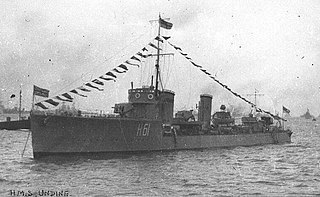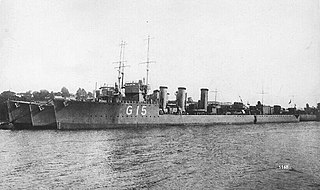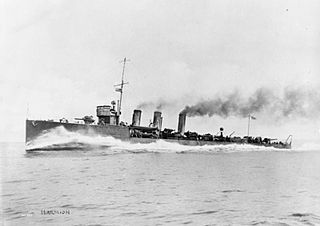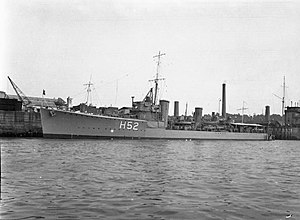
HMS Rosalind was an R-class destroyer which served with the Royal Navy. The ship was launched by Thornycroft on 14 October 1916 as the first of five similar ships ordered from the yard. The design was used as the basis for five subsequent ships of the S-class also built by the company. Rosalind served as part of the Grand Fleet during the First World War, operating as an escort to other warships and in anti-submarine patrols alongside other destroyers. The vessel was sold to be broken up on 13 July 1926.

HMS Taurus was an R-class destroyer which served with the Royal Navy during World War I. Ordered from Thornycroft in 1915 and launched in 1917, the vessel operated as part of the Harwich Force until the end of hostilities. Shortly after entering service, Taurus formed part of the destroyer shield for the Royal Navy's bombardment of Ostend that successfully sank the German destroyer S20. After the War, the destroyer was reduced to the Reserve Fleet and sold to be broken up in 1930.

HMS Tristram was a modified Admiralty R-class destroyer that served in the Royal Navy during the First World War. The Modified R class added attributes of the Yarrow Later M class to improve the capability of the ships to operate in bad weather. Launched in 1917, the destroyer was operational for just over four years. In 1917, Tristram joined the Grand Fleet and provided distant cover at the Second Battle of Heligoland Bight but did not engage with the enemy. After the armistice which ended the war, the destroyer was initially transferred to the Home Fleet before being placed in reserve in 1920 and then sold to be broken up in 1921.

HMS Ursa was a modified Admiralty R-class destroyer that served in the Royal Navy during the First World War. The Modified R class added attributes of the Yarrow Later M class to improve the capability of the ships to operate in bad weather. Launched in 1917, the vessel saw service as part of the Grand Fleet. The destroyer took part in the Second Battle of Heligoland Bight while being commanded by Commander John Tovey, who later became Admiral of the Fleet and led the successful action against the battleship Bismark. The vessel was also one of the first destroyers to launch a torpedo at the enemy during the battle. After the war, Ursa was transferred to the Home Fleet, but was sold to be broken up in 1928.

HMS Urchin was a Modified Admiralty R-class destroyer which served with the Royal Navy during the First World War. The Modified R class added attributes of the Yarrow Later M class to improve the capability of the ships to operate in bad weather. The destroyer was the third ship in the Navy to be named after the sea urchin and the first in the class to be built by Palmers in Jarrow. Launched in 1917, Urchin served with the Grand Fleet, seeing action in the Second Battle of Heligoland Bight. After the war, the destroyer was remained in service until being retired and sold to be broken up in 1930.

HMS Ursula was a Modified Admiralty R-class destroyer that served in the Royal Navy. The Modified R class added attributes of the Yarrow Later M class to improve the capability of the ships to operate in bad weather. The vessel was launched in 1917 at Greenock in Scotland and served with the Grand Fleet during the First World War. After the war, the destroyer was transferred to the Home Fleet, but then moved to the Reserve Fleet. In 1924, Prince George served aboard Ursula before, in 1929, the vessel was sold to be broken up.

HMS Tirade was a Modified Admiralty R-class destroyer which served with the Royal Navy during World War I. The Modified R class added attributes of the Yarrow Later M class to improve the capability of the ships to operate in bad weather. Launched in April 1917 by Scotts Shipbuilding and Engineering Company, the vessel served with the Grand Fleet. The vessel was involved in escorting convoys in the Irish Sea and North Sea. During one of these duties, in September 1917, Tirade sank the minelaying submarine UC-55. During the following month, the destroyer accidentally struck and sank the M-class destroyer Marmion. After the war the destroyer was placed in reserve and then, in November 1921, was sold to be broken up.

HMS Raider was the second of a class of sixty two R-class destroyers operated by the Royal Navy. Launched in 1916, the vessel served with the Grand Fleet during World War I. The destroyer was built as part of the preceding M-class but was equipped with geared turbines which improved efficiency and increased range. The ship was involved in anti-submarine patrols, but did not sink any German submarines. After the war, the destroyer initially moved to Harwich and was briefly stationed in Ireland after the Irish Civil War. In 1923, the Navy decided to retire the older destroyers in the fleet and, although initially spared, Raider was decommissioned and sold to be broken up in 1927.

HMS Rowena was an R-class destroyer which served with the Royal Navy during World War I. Launched on 1 July 1916, the ship operated as part of the Grand Fleet as part of a destroyer flotilla hunting for German vessels that were attacking convoys in the North Sea. Although there were many reported sightings, no submarines were sunk. After the conflict, the vessel was transferred to the Navy’s establishment at Portland to help in the development of anti-submarine warfare, which ultimately helped in the Battle of the Atlantic. Rowena did not, however, see the fruit of this labour. After twenty years of service, the destroyer was retired and sold to be broken up on 27 January 1937.

HMS Plover was a Admiralty M-class destroyer which served with the Royal Navy during the First World War. The M class were an improvement on the previous L-class, capable of higher speed. Launched on 3 March 1916 by Hawthorn Leslie on the River Tyne, the vessel served as part of the Grand Fleet. Plover was based at Scapa Flow and took part in sorties in response to German submarine activity. After an uneventful war, the destroyer was placed in reserve and decommissioned, being sold to be broken up on 9 May 1921.

HMS Maenad was an Admiralty M-class destroyer which served with the Royal Navy during the First World War. The M class were an improvement on the previous L class, capable of higher speed. The vessel, launched in 1915, served in the Battle of Jutland in 1916, attacking both battleships and destroyers of the German High Seas Fleet. However, the vessel was notorious for undertaking a sharp manoeuvre which obstructed other destroyers in the fleet from attacking. Maenad also undertook anti-submarine patrols. In 1917, the ship mistakenly attacked the British submarine G12 thinking it was a German boat. The submarine escaped with damages. After the armistice that ended of the war, Maenad was placed in reserve until being sold to be broken up in Germany in 1921.

HMS Tara was an S-class destroyer, which served with the Royal Navy. Launched on 7 August 1918, the vessel entered service at the closing of the First World War. The ship joined the Fourteenth Destroyer Flotilla of the Grand Fleet but was placed in Reserve at Nore in 1919. Tara deteriorated over the following years and was sold to be broken up on 17 December 1931 after the signing of the London Naval Treaty that limited the amount of destroyer tonnage the Navy could retain.

HMS Trojan was an S-class destroyer, which served with the Royal Navy. The vessel was the only one named in honour of the citizens of Troy that has been operated by the navy. Launched on 12 July 1918, Trojan was too late to see service in the First World War. Initially allocated to the Grand Fleet and then, when this was dissolved, the Atlantic Fleet, the destroyer was transferred to the Reserve Fleet, like many of the class, within two years of being first commissioned. The vessel remained in reserve until 24 September 1936, although in a deteriorating condition. On that day, Trojan was sold to be broken up as part of a deal for the liner Majestic.

HMS Sepoy was an S-class destroyer, which served with the Royal Navy during the First World War and the Russian Civil War. Sepoy was launched in 1918 and initially joined the Grand Fleet. After the Armistice that ended the First World War, the ship was briefly transferred to the Reserve Fleet before sailing to Tallinn in 1919 as part of the Royal Navy response to the fighting there. Sepoy rejoined the Reserve Fleet at the end of the year. In 1922, the destroyer served in the Mediterranean Sea. The ship was later allocated to the naval base in Hong Kong, arriving in 1929. During exercises the following year, a depth charge explosion killed six sailors. The destroyer was also damaged. Following the signing of the London Naval Treaty a few days later, Sepoy returned to the United Kingdom and, in 1932, was sold to be broken up at Newport, Wales.

HMS Peregrine was a Admiralty M-class destroyer that served with the Royal Navy during the First World War. The M class were an improvement on the preceding L class, capable of higher speed. Launched on 29 May 1916, the vessel served with the Grand Fleet, focusing on anti-submarine warfare. In 1917, the destroyer was involved in the search for UC-65 after the submarine had sunk the protected cruiser Ariadne. In 1918, the ship participated in one of the final sorties of the war, although this did not lead to a confrontation with the German High Seas Fleet. After the Armistice that ended the war, the destroyer was placed in reserve and subsequently sold to be broken up on 9 May 1921.

HMS Mons was an Admiralty M-class destroyer which served with the Royal Navy during the First World War and fought in the Battle of Jutland. The M class was an improvement on the preceding L class, capable of higher speeds. The ship, the first British naval vessel to be named after the Battle of Mons, was launched in 1915. Joining the Grand Fleet as part of the new Eleventh Destroyer Flotilla, the destroyer was soon in action, taking part in patrols that aimed to draw out the German High Seas Fleet. During the Battle of Jutland in 1916, Mons attacked the German light cruisers at the forefront of the German battleline but scored no hits. After the armistice, the destroyer was placed in reserve. Mons was found to be worn out by wartime operations and, despite only serving for six years, in 1921, was sold to be broken up.

HMS Northesk was an Admiralty M-class destroyer which served in the Royal Navy during the First World War. The M class was an improvement on the previous L-class destroyer, capable of higher speed. The vessel was launched in 1916 and joined the Grand Fleet. Northesk was involved in escorting convoys, including the first southbound convoy on the coastal route between Lerwick and Immingham in 1917. After the Armistice that marked the end of the First World War, the destroyer joined the Mediterranean Fleet and operated in the area around Sevastopol, including assisting in the evacuation of the Crimea in 1919. Soon afterwards, in 1921, Northesk was decommissioned and sold to be broken up.

HMS Onslaught was a Admiralty M-class destroyer which served with the Royal Navy during the First World War. The M class were an improvement on the previous L-class, capable of higher speed. The vessel, launched in 1915, joined the Twelfth Destroyer Flotilla under the flotilla leader Faulknor. The ship saw action during the Battle of Jutland in May 1916, jointly sinking the German torpedo boat SMS V48 and launching the torpedo that sank the pre-dreadnought battleship Pommern, the only German battleship to be lost in the battle. Subsequently, the destroyer acted as an escort to other naval ships during the Action of 19 August 1916 and took part in anti-submarine operations. At the end of the war, Onslaught was withdrawn from service and, in 1921, sold to be broken up.

HMS Redpole was one of 20 Acorn-class destroyers built for the Royal Navy that served in the First World War. The Acorn class were smaller than the preceding Beagle class but oil-fired and better armed. Launched in 1910, the ship served with the Second Destroyer Flotilla, joining the Grand Fleet at the start of the war, and was transferred to the Mediterranean Fleet in 1915, joining the Fifth Destroyer Flotilla. Employed as an escort, the ship also undertook other duties, including rescuing the Italian destroyer Benedetto Cairoli in 1918. Redpole ended the war in Gibraltar. After the Armistice, the destroyer was placed in reserve before being sold to be broken up in 1921.

HMS Seabear was an S-class destroyer that served with the Royal Navy during the Russian Civil War. The S class was a development of the previous R class, with minor differences, constructed at the end of the First World War. Seabear was launched in December 1917 and joined the Grand Fleet for the last few months of the War. The destroyer then joined the British campaign in the Baltic, sailing as part of a detachment of ten destroyers under the command of Admiral Walter Cowan in March 1919. Seabear sailed to Tallinn in support of the Estonian War of Independence the following month. On returning to the UK, the ship was placed in reserve. The London Naval Treaty limited to number of destroyers that the Royal Navy could operate and, as new ships entered service, older vessels were retired. Seabear was sold in February 1931 and broken up.















